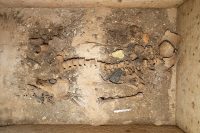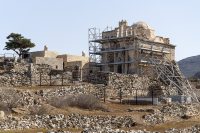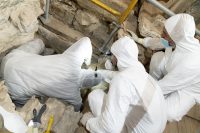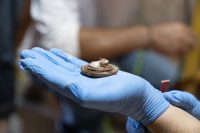 Archaeologists have discovered the intact tomb of a prominent woman under Episkopi Monument on the Cyclades island of Sikinos. She was buried with fine jewelry including gold bracelets, finger rings, a necklace and a high relief cameo brooch. Other goods found in the grave include glass and metal vases. Of no monetary value but immense archaeological value is organic material believed to be textile fragments from her burial garments.
Archaeologists have discovered the intact tomb of a prominent woman under Episkopi Monument on the Cyclades island of Sikinos. She was buried with fine jewelry including gold bracelets, finger rings, a necklace and a high relief cameo brooch. Other goods found in the grave include glass and metal vases. Of no monetary value but immense archaeological value is organic material believed to be textile fragments from her burial garments.
 The Episkopi Monument was originally a Roman-era mausoleum built in the 3rd century A.D. and later converted into a temple to Pythian Apollo. The dome was added in the 5th century when the temple was converted into a Christian church. The Byzantine church was severely damaged in an earthquake, but much of it remains standing. Its height and long history of usage from antiquity through the Middle Ages make it unique in Greece.
The Episkopi Monument was originally a Roman-era mausoleum built in the 3rd century A.D. and later converted into a temple to Pythian Apollo. The dome was added in the 5th century when the temple was converted into a Christian church. The Byzantine church was severely damaged in an earthquake, but much of it remains standing. Its height and long history of usage from antiquity through the Middle Ages make it unique in Greece.
 Because of its eventful past, the monument is in regular need of restoration. A team of experts from the Ministry of Culture and Sports and the Cyclades Ephorate of Antiquities has been working on an extensive restoration project since last year. It was during the restoration work that the grave was discovered in a concealed section of the site’s underground crypt. The rectangular stone tomb was likely deliberately hidden to keep its owner and her treasures out of reach of looters.
Because of its eventful past, the monument is in regular need of restoration. A team of experts from the Ministry of Culture and Sports and the Cyclades Ephorate of Antiquities has been working on an extensive restoration project since last year. It was during the restoration work that the grave was discovered in a concealed section of the site’s underground crypt. The rectangular stone tomb was likely deliberately hidden to keep its owner and her treasures out of reach of looters.
 The burial has not been dated yet, but the artifacts suggest it is from late antiquity around the time when the mausoleum was built. Archaeologists think the woman’s burial may be the one for which the large mausoleum was erected in the first place. Besides her obvious wealth, the importance of the stone coffin and the hidden placement, another clue that points towards the funerary structure having been built to mark her tomb is an single-word inscription discovered in the mausoleum. It is the female name “Νεικώ” (Neiko). Perhaps Neiko has now been found.
The burial has not been dated yet, but the artifacts suggest it is from late antiquity around the time when the mausoleum was built. Archaeologists think the woman’s burial may be the one for which the large mausoleum was erected in the first place. Besides her obvious wealth, the importance of the stone coffin and the hidden placement, another clue that points towards the funerary structure having been built to mark her tomb is an single-word inscription discovered in the mausoleum. It is the female name “Νεικώ” (Neiko). Perhaps Neiko has now been found.